$.ajax({ type: "get", url: "http://localhost:27221/api/Charging/GetByModel", contentType: "application/json", data: { ID: "1", NAME: "Jim", CREATETIME: "1988-09-11" }, success: function (data, status) { if (status == "success") { $("#div_test").html(data); } } });
[HttpGet] public string GetAllChargingData([FromUri]TB_CHARGING obj) { return "ChargingData" + obj.ID; }
得到结果:
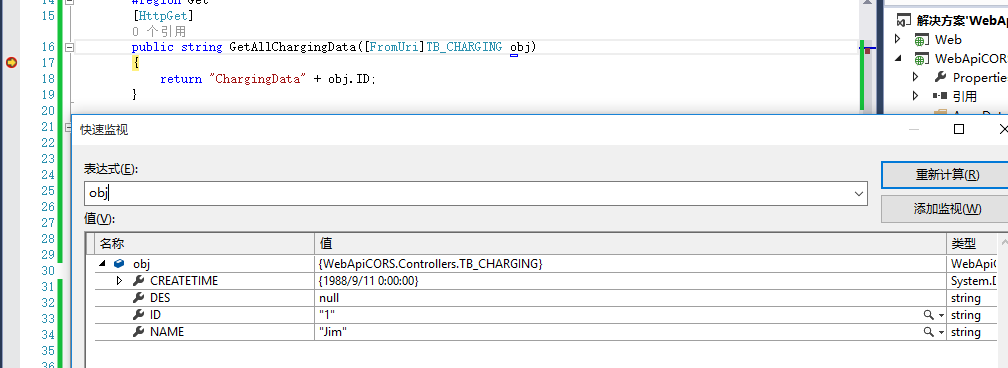
如果你不想使用[FromUri]这些在参数里面加特性的这种“怪异”写法,也可以采用先序列化,再在后台反序列的方式。
$.ajax({ type: "get", url: "http://localhost:27221/api/Charging/GetByModel", contentType: "application/json", data: { strQuery: JSON.stringify({ ID: "1", NAME: "Jim", CREATETIME: "1988-09-11" }) }, success: function (data, status) { if (status == "success") { $("#div_test").html(data); } } });
[HttpGet] public string GetByModel(string strQuery) { TB_CHARGING oData = Newtonsoft.Json.JsonConvert.DeserializeObject<TB_CHARGING>(strQuery); return "ChargingData" + oData.ID; }

这样在后台得到我们序列化过的对象,再通过反序列化就能得到对象。
数组作为参数
一般get请求不建议将数组作为参数,因为我们知道get请求传递参数的大小是有限制的,最大1024字节,数组里面内容较多时,将其作为参数传递可能会发生参数超限丢失的情况。
$.ajax({ type: "get", url: "http://localhost:27221/api/Charging/FindByModel", contentType: "application/json", data: { strQuery: JSON.stringify({ ID: "1", NAME: "Jim", CREATETIME: "1988-09-11" }) }, success: function (data, status) { if (status == "success") { $("#div_test").html(data); } } });
[HttpGet] public string FindByModel(string strQuery) { TB_CHARGING oData = Newtonsoft.Json.JsonConvert.DeserializeObject<TB_CHARGING>(strQuery); return "ChargingData" + oData.ID; }
方法名以Get开头,WebApi会自动默认这个请求就是get请求,而如果你以其他名称开头而又不标注方法的请求方式,那么这个时候服务器虽然找到了这个方法,但是由于请求方式不确定,所以直接返回给你405——方法不被允许的错误。
最后结论:所有的WebApi方法最好是加上请求的方式([HttpGet]/[HttpPost]/[HttpPut]/[HttpDelete]),不要偷懒,这样既能防止类似的错误,也有利于方法的维护,别人一看就知道这个方法是什么请求。
二、post请求
在WebApi的RESETful风格里面,API服务的增删改查,分别对应着http的post/delete/put/get请求。我们下面就来说说post请求参数的传递方式。
1、基础类型参数
post请求的基础类型的参数和get请求有点不一样,我们知道get请求的参数是通过url来传递的,而post请求则是通过http的请求体中传过来的,WebApi的post请求也需要从http的请求体里面去取参数。
(1)错误的写法
$.ajax({ type: "post", url: "http://localhost:27221/api/Charging/SaveData", data: { NAME: "Jim" }, success: function (data, status) { if (status == "success") { $("#div_test").html(data); } } }); [HttpPost] public bool SaveData(string NAME) { return true; }
这是一种看上去非常正确的写法,可是实际情况是:
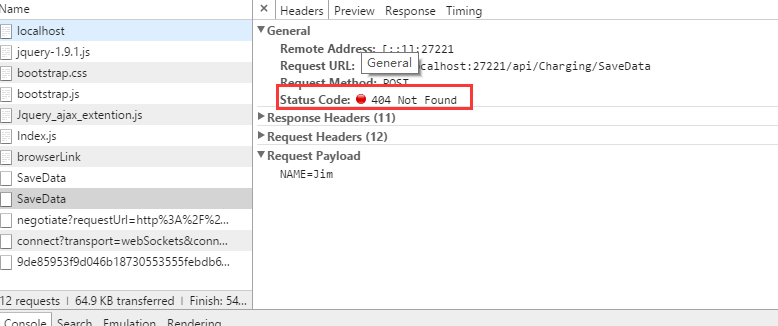
(2)正确的用法
$.ajax({ type: "post", url: "http://localhost:27221/api/Charging/SaveData", data: { "": "Jim" }, success: function (data, status) {} }); [HttpPost] public bool SaveData([FromBody]string NAME) { return true; }
这是一种另许多人头痛的写法,但是没办法,这样确实能得到我们的结果:

我们一般的通过url取参数的机制是键值对,即某一个key等于某一个value,而这里的FromBody和我们一般通过url取参数的机制则不同,它的机制是=value,没有key的概念,并且如果你写了key(比如你的ajax参数写的{NAME:"Jim"}),后台反而得到的NAME等于null。不信你可以试试。
上面讲的都是传递一个基础类型参数的情况,那么如果我们需要传递多个基础类型呢?按照上面的推论,是否可以([FromBody]string NAME, [FromBody]string DES)这样写呢。试试便知。
(1)错误写法
$.ajax({ type: "post", url: "http://localhost:27221/api/Charging/SaveData", data: { "": "Jim","":"备注" }, success: function (data, status) {} }); [HttpPost] public bool SaveData([FromBody]string NAME, [FromBody] string DES) { return true; }
得到结果
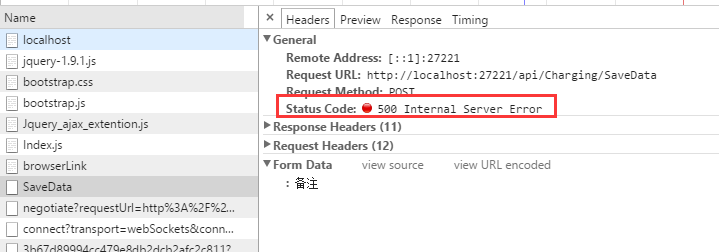

这说明我们没办法通过多个[FromBody]里面取值,此法失败。
(2)正确用法
既然上面的办法行不通,那我们如何传递多个基础类型的数据呢?很多的解决办法是新建一个类去包含传递的参数,博主觉得这样不够灵活,因为如果我们前后台每次传递多个参数的post请求都去新建一个类的话,我们系统到时候会有多少个这种参数类?维护起来那是相当的麻烦的一件事!所以博主觉得使用dynamic是一个很不错的选择。我们来试试。
$.ajax({ type: "post", url: "http://localhost:27221/api/Charging/SaveData", contentType: 'application/json', data: JSON.stringify({ NAME: "Jim",DES:"备注" }), success: function (data, status) {} }); [HttpPost] public object SaveData(dynamic obj) { var strName = Convert.ToString(obj.NAME); return strName; }
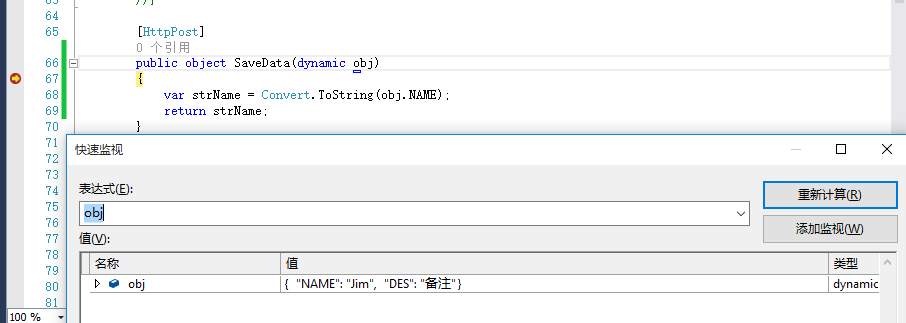
通过dynamic动态类型能顺利得到多个参数,省掉了[FromBody]这个累赘,并且ajax参数的传递不用使用"无厘头"的{"":"value"}这种写法,有没有一种小清新的感觉~~有一点需要注意的是这里在ajax的请求里面需要加上参数类型为Json,即 contentType: 'application/json', 这个属性。
通过上文post请求基础类型参数的传递,我们了解到了dynamic的方便之处,为了避免[FromBody]这个累赘和{"":"value"}这种"无厘头"的写法。博主推荐所有基础类型使用dynamic来传递,方便解决了基础类型一个或多个参数的传递,示例如上文
2、实体作为参数
(1)单个实体作为参数
上面我们通过dynamic类型解决了post请求基础类型数据的传递问题,那么当我们需要传递一个实体作为参数该怎么解决呢?我们来看下面的代码便知:
$.ajax({ type: "post", url: "http://localhost:27221/api/Charging/SaveData", data: { ID: "1", NAME: "Jim", CREATETIME: "1988-09-11" }, success: function (data, status) {} }); [HttpPost] public bool SaveData(TB_CHARGING oData) { return true; }
得到结果
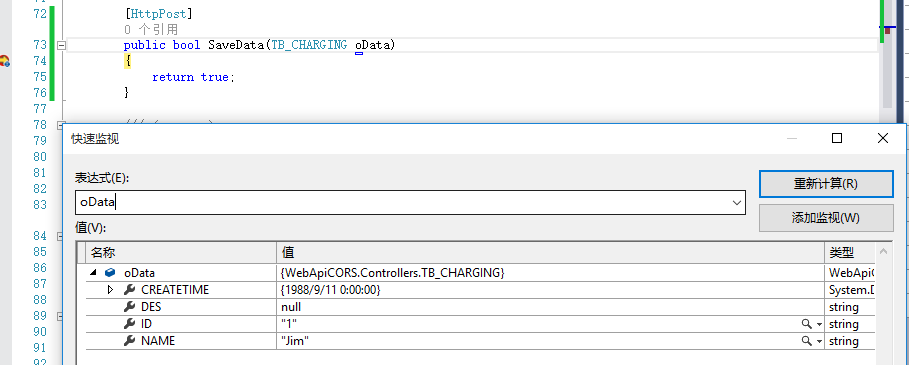
原理解释:使用实体作为参数的时候,前端直接传递普通json,后台直接使用对应的类型去接收即可,不用FromBody。但是这里需要注意的一点就是,这里不能指定contentType为appplication/json,否则,参数无法传递到后台。我们来看看它默认的contentType是什么:

为了弄清楚原因,博主查了下http的Content-Type的类型。看到如下说明:
- application/x-www-form-urlencoded : <form encType=””>中默认的encType,form表单数据被编码为key/value格式发送到服务器(表单默认的提交数据的格式);
- application/json : JSON数据格式
也就是说post请求默认是将表单里面的数据的key/value形式发送到服务,而我们的服务器只需要有对应的key/value属性值的对象就可以接收到。而如果使用application/json,则表示将前端的数据以序列化过的json传递到后端,后端要把它变成实体对象,还需要一个反序列化的过程。按照这个逻辑,那我们如果指定contentType为application/json,然后传递序列化过的对象应该也是可以的啊。博主好奇心重,还是打算一试到底,于是就有了下面的代码:
var postdata = { ID: "1", NAME: "Jim", CREATETIME: "1988-09-11" }; $.ajax({ type: "post", url: "http://localhost:27221/api/Charging/SaveData", contentType: 'application/json', data: JSON.stringify(postdata), success: function (data, status) {} }); [HttpPost] public bool SaveData(TB_CHARGING lstCharging) { return true; }
得到结果:
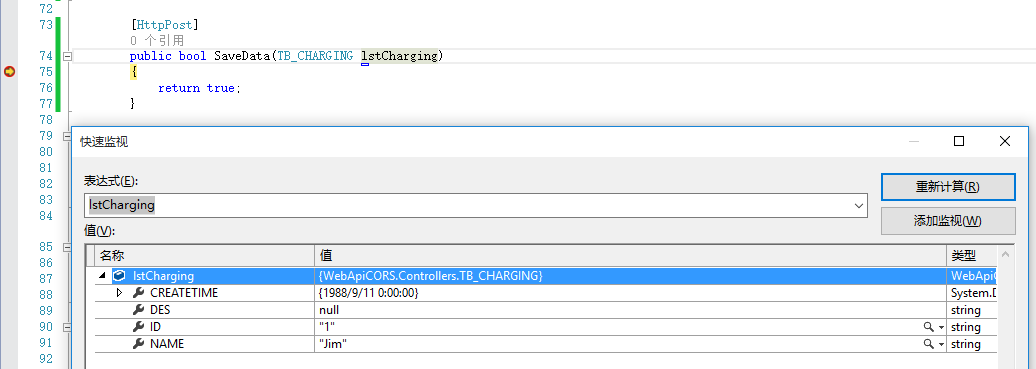
尝试成功,也就是说,两种写法都是可行的。如果你指定了contentType为application/json,则必须要传递序列化过的对象;如果使用post请求的默认参数类型,则前端直接传递json类型的对象即可。
(2)实体和基础类型一起作为参数传递
有些时候,我们需要将基础类型和实体一起传递到后台,这个时候,我们神奇的dynamic又派上用场了。
var postdata = { ID: "1", NAME: "Jim", CREATETIME: "1988-09-11" }; $.ajax({ type: "post", url: "http://localhost:27221/api/Charging/SaveData", contentType: 'application/json', data: JSON.stringify({ NAME:"Lilei", Charging:postdata }), success: function (data, status) {} }); [HttpPost] public object SaveData(dynamic obj) { var strName = Convert.ToString(obj.NAME); var oCharging = Newtonsoft.Json.JsonConvert.DeserializeObject<TB_CHARGING>(Convert.ToString(obj.Charging)); return strName; }
得到结果:

3、数组作为参数
(1)基础类型数组
var arr = ["1", "2", "3", "4"]; $.ajax({ type: "post", url: "http://localhost:27221/api/Charging/SaveData", contentType: 'application/json', data: JSON.stringify(arr), success: function (data, status) { } }); [HttpPost] public bool SaveData(string[] ids) { return true; }
得到结果:
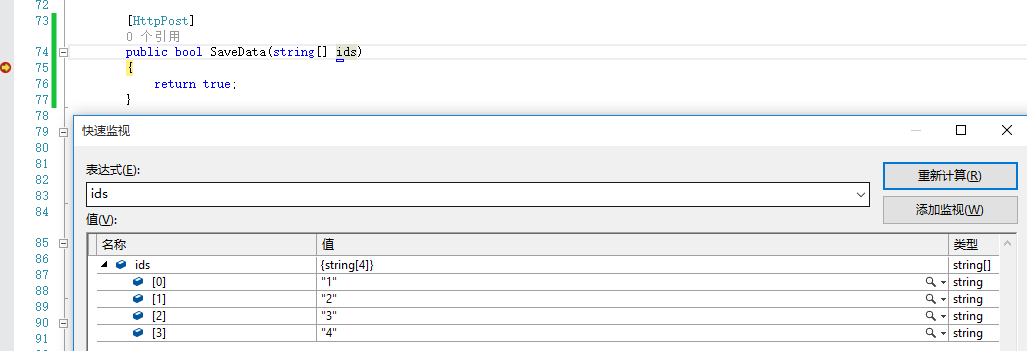
(2)实体集合
var arr = [ { ID: "1", NAME: "Jim", CREATETIME: "1988-09-11" }, { ID: "2", NAME: "Lilei", CREATETIME: "1990-12-11" }, { ID: "3", NAME: "Lucy", CREATETIME: "1986-01-10" } ]; $.ajax({ type: "post", url: "http://localhost:27221/api/Charging/SaveData", contentType: 'application/json', data: JSON.stringify(arr), success: function (data, status) {} }); [HttpPost] public bool SaveData(List<TB_CHARGING> lstCharging) { return true; }
得到结果:

4、后台发送请求参数的传递
上面写了那么多,都是通过前端的ajax请求去做的,我们知道,如果调用方不是web项目,比如Android客户端,可能需要从后台发送http请求来调用我们的接口方法,如果我们通过后台去发送请求是否也是可行的呢?我们以实体对象作为参数来传递写写代码试一把。
public void TestReques() { //请求路径 string url = "http://localhost:27221/api/Charging/SaveData"; //定义request并设置request的路径 WebRequest request = WebRequest.Create(url); request.Method = "post"; //初始化request参数 string postData = "{ ID: "1", NAME: "Jim", CREATETIME: "1988-09-11" }"; //设置参数的编码格式,解决中文乱码 byte[] byteArray = Encoding.UTF8.GetBytes(postData); //设置request的MIME类型及内容长度 request.ContentType = "application/json"; request.ContentLength = byteArray.Length; //打开request字符流 Stream dataStream = request.GetRequestStream(); dataStream.Write(byteArray, 0, byteArray.Length); dataStream.Close(); //定义response为前面的request响应 WebResponse response = request.GetResponse(); //获取相应的状态代码 Console.WriteLine(((HttpWebResponse)response).StatusDescription); //定义response字符流 dataStream = response.GetResponseStream(); StreamReader reader = new StreamReader(dataStream); string responseFromServer = reader.ReadToEnd();//读取所有 Console.WriteLine(responseFromServer); }
当代码运行到request.GetResponse()这一句的时候,API里面进入断点
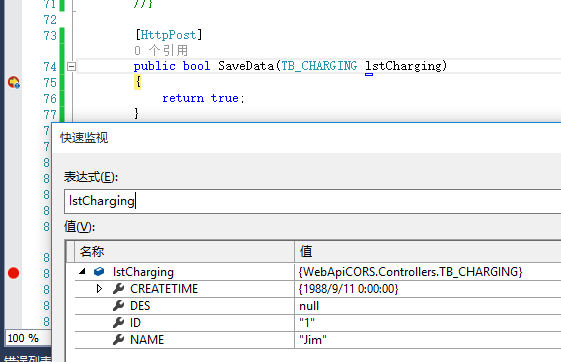
尝试成功。
三、put请求
WebApi里面put请求一般用于对象的更新。它和用法和post请求基本相同。同样支持[FromBody],同样可以使用dynamic。
1、基础类型参数
$.ajax({ type: "put", url: "http://localhost:27221/api/Charging/Update", contentType: 'application/json', data: JSON.stringify({ ID: "1" }), success: function (data, status) {} }); [HttpPut] public bool Update(dynamic obj ) { return true; }
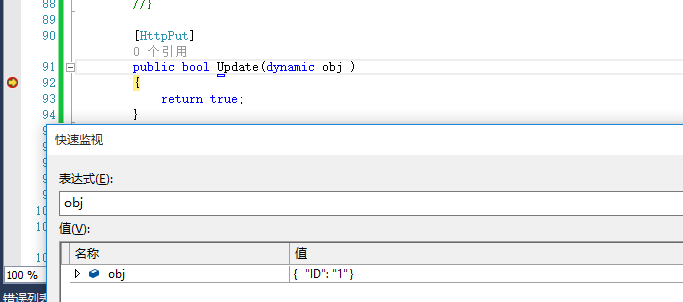
2、实体作为参数
和post请求相同。
3、数组作为参数
和post请求相同。
四、delete请求
顾名思义,delete请求肯定是用于删除操作的。参数传递机制和post也是基本相同。下面简单给出一个例子,其他情况参考post请求。
var arr = [ { ID: "1", NAME: "Jim", CREATETIME: "1988-09-11" }, { ID: "2", NAME: "Lilei", CREATETIME: "1990-12-11" }, { ID: "3", NAME: "Lucy", CREATETIME: "1986-01-10" } ]; $.ajax({ type: "delete", url: "http://localhost:27221/api/Charging/OptDelete", contentType: 'application/json', data: JSON.stringify(arr), success: function (data, status) {} }); [HttpDelete] public bool OptDelete(List<TB_CHARGING> lstChargin) { return true; }
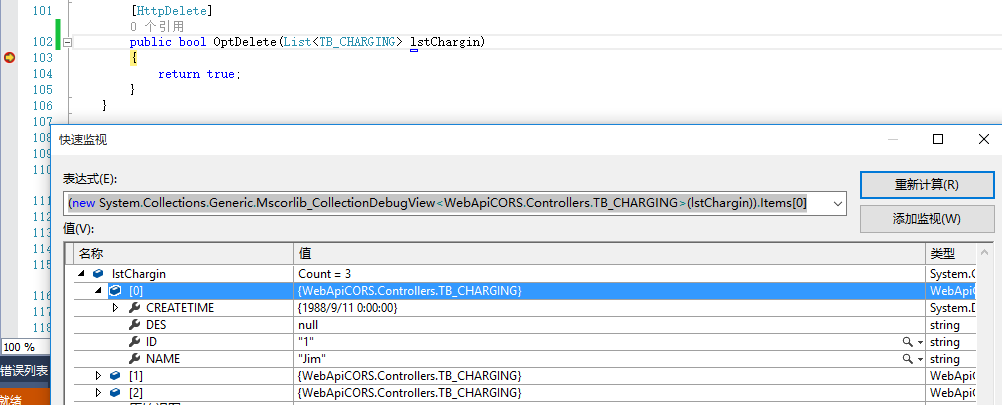
博文的一点评论:
dynamic虽然很巧妙地解决了从请求body中获取参数。但是这样不利于生成api文档。
ps:一般都是用pagehelp等工具,自动读取元数据,生成api文档的。
如果用dynamic的话,生成的文档就只有一个dynamic类型的参数,这样api调用者就无法明确api的参数了。
还有接收参数定义为dynamic类型的话,后续维护或升级太麻烦。
如果是post操作。文中介绍了两种传递实体参数的方法
第一种:
|
1
|
data: { ID: "1", NAME: "Jim", CREATETIME: "1988-09-11" } |
不需要指定contentType。
第二种:
|
1
|
data: "{"SoldToParty":"fdsfds","SaleOrg":"fdsfds","Channel":"ffffff","Division":"dfdfsdsfd"}" |
需要指定contentType:"application/json"。两种方式后台都可以得到实体。不知道你的Json字符串是怎么得到的,是拼的字符串?建议使用JSON.stringify( { ID: "1", NAME: "Jim", CREATETIME: "1988-09-11" })这种方式得到json字符串。
HttpPost传单个变量
[HttpPost]
public JsonResult DeleteFrequencyInfo(List<string> ids)
$.ajax(
{
url: "/Frequency/DeleteFrequencyInfo",
type: "post",
data: { "ids": deleted },
dataType: "json",
HttpPost传实体
[HttpPost]
public JsonResult GetFrequencyPrint(FrequencyPrintQO request)
public class FrequencyPrintQO
{
public string FrequencyId { get; set; }
public List<string> Freedombarcodes { get; set; }
}
$.ajax({
type: "POST",
url: '/Print/GetFrequencyPrint',
dataType: "Json",
async: false, // 此处必须定义为同步
data: {Freedombarcodes: freedombarcodes},
参考:http://www.cnblogs.com/landeanfen/p/5337072.html